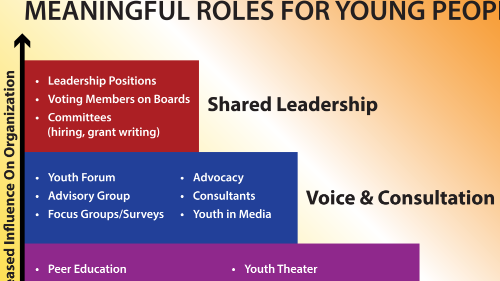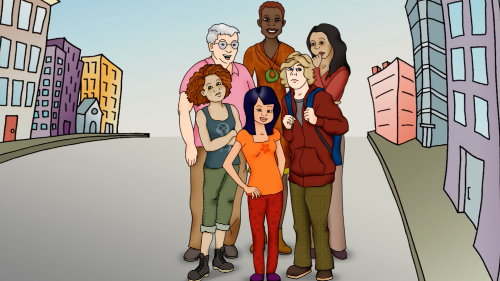Positive Environments: Features of Youth Development Settings
Young people grow up in a variety of social settings: families, schools, youth programs, health care environments, child welfare and juvenile justice systems, and more. We can best support positive outcomes by creating positive, developmental environments within — and strengthening connections among — these settings [1].

What are positive, developmental environments?
Positive environments are social settings that are safe, inclusive, and welcoming, where young people feel a sense of belonging and know that they are valued. When contexts like these are also rich in learning opportunities, young people can undertake challenges, fail productively, and try again without coming to emotional or physical harm. In other words, these are "developmental" settings.
Features of Effective Youth Development Settings
What does the research say about how to structure positive, developmental environments for youth? In 2002, Jacquelynne Eccles, Jennifer Appleton Gootman, and colleagues released an important book: Community Programs to Promote Youth Development [2]. They reviewed community-based programs that had been shown to achieve positive outcomes for (and with) youth. Through the review they identified eight features of successful youth development programs. Though the language has changed over time and new frameworks have been developed, these features still serve as a measuring tool or standard for effective developmental settings:
- Physical and Psychological Safety
- Appropriate Structure
- Supportive Relationships
- Opportunities to Belong
- Positive Social Norms
- Support for Efficacy and Mattering
- Opportunities for Skill Building
- Integration of Family, School, and Community Efforts
Physical and Psychological Safety: Trauma-Informed Approach
To build positive environments we must continually take into account the pervasiveness of trauma. Young people (including staff) who have experienced — or are currently experiencing — traumatizing circumstances need to feel safe both physically and emotionally if they are going to engage. Many resources have been developed to guide us in creating trauma-informed settings. While a sense of safety is fundamental to learning and growth, it's also important to keep the other developmental features in mind. In their book Reaching Teens, Kenneth Ginsburg and Zachary Brett Ramirez McClain stress that "traumatized" should not become another label slapped onto young people — a condition that determines what they are capable of and will become [3]. A trauma-informed approach to youth development is strength-based, supports young people's agency, and holds all young people to high standards.
Appropriate Structure
Young people need clear and consistent expectations, continuity and predictability, clear boundaries, and age-appropriate monitoring. The word "appropriate" is important here, though it needs contextual definition. While structure is important, binding youth to too many rules and controls does not promote development. Young people need to be able to take risks safely and engage in opportunities that are typical for their peers. When the adults, institutions, and policies governing a young person's life are overly punitive and authoritarian or too focused on preventing risks, these adult attitudes and rules become obstacles to development. "Appropriate structure" needs to be clearly defined and communicated within an organization so that all staff (and, ultimately, youth) understand where, how, and why the lines are drawn as they are, and when there can be flexibility.
Supportive Relationships
Warm, connected, sustained relationships with adults are essential to healthy youth development. Today we use the term developmental relationships to describe this feature: relationships between youth and adults that are characterized by caring, support, growth, inclusion, partnership, and youth agency.
Opportunities to Belong: Inclusive Program Environments
ACT for Youth defines belonging as the feeling of being an accepted, valued, and legitimate group member [4]. We know that belonging is a fundamental need of human beings — we all need to belong. Neuroscience has confirmed that we are hard-wired to connect. Whenever we come into a room, we immediately check who is there: do we know them, do we like them, do we have something in common? We constantly monitor this feeling of belonging. And we all have had the experience of sensing we don't belong, which leads to discomfort and pain. A feeling of exclusion can have serious psychological impact. Learn more about inclusiveness and belonging in program settings.
Positive Social Norms
The culture, attitudes, and values expressed or enacted by adults and youth in a particular setting are highly influential. In a strength-based organization that aims for positive outcomes, it's important to elicit, model, and cultivate prosocial norms as well. At the program level this may begin with positive ground rules generated by the group. Young people will often step up to enforce group rules, especially when they've participated in creating those rules and norms. By guiding the group toward positive rules that reinforce belonging and point toward shared goals, we can create a reference point to help adults and youth alike practice good communication, inclusiveness, self-regulation, or other shared values.
Support for Efficacy and Mattering; Opportunities for Skill Building
All of us need evidence that we matter to others; we need to see that we are taken seriously and can make a difference. Eccles and Gootman include in this feature "the opportunity to experience meaningful challenge," because we gain belief in our abilities as we see ourselves stretching and improving through our efforts. Learn more about meaningful roles for youth in our youth engagement section; find skill building resources in our Activity Toolkits.
Integration of Family, School, and Community Efforts
Positive youth development is not just a program — and one family, school, or agency cannot provide all the services, opportunities, and supports a young person needs to thrive. Through the ecological lens that is one of the foundations of PYD, we understand that all of the social groups and institutions a young person is connected to can provide or withhold resources. We are all responsible for the youth in our community. Youth development is everybody's business.
Resources
Features of Positive Developmental Settings
This chart offers a descriptor of what each of the eight features of effective youth development settings is, and what it is not. ACT for Youth.
PYD Environmental Scan
This tool can be used to do an informal assessment of the physical environment and climate of the agency. It is based on many PYD trainings and discussions with youth work professionals. ACT for Youth.
Whole-Child Design: Supportive Environments
We know that for learning and development, context matters. Here, research-based resources are offered to help set the stage for developmentally supportive environments. Turnaround for Children.
References
- National Academies of Sciences, Engineering, and Medicine. (2019). The Promise of Adolescence: Realizing Opportunity for All Youth. Washington, DC: The National Academies Press.
www.nap.edu/catalog/25388/the-promise-of-adolescence-realizing-opportunity-for-all-youth
- Eccles, J., & Gootman, J. (Eds.). (2002). Community Programs to Promote Youth Development. National Research Council — Institute of Medicine. Washington, DC: National Academy Press.
- Ginsburg, K. R., & McClain, Z. B. R. (Eds.). (2020). Reaching Teens: Strength-Based, Trauma-Sensitive, Resilience-Building Communication Strategies Rooted in Positive Youth Development (2nd ed.). American Academy of Pediatrics.
- Dotterweich, J. (2020). Creating Inclusive Program Environments for Youth with Different Abilities: A Curriculum for Youth Work Professionals. ACT for Youth.
actforyouth.net/resources/ipe/inclusive-program-environments-manual.pdf







